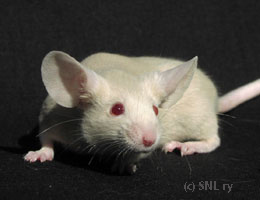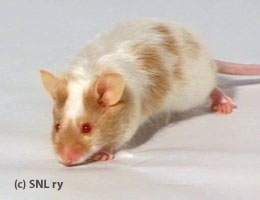Varieties
Type, Temperament, Health
Fancy Mice - an Introduction
You may have noticed that there are actually two different 'kinds' of mice around (or three, counting "mini-mice", a dwarfed version of Mus musculus) - one being much larger than the other . As well as being larger, the larger mice have much larger ears, longer and stronger, well set-on tail, big bold eyes, long and muscular but still lean body and strong head. The smaller mice have small ears, smaller eyes, a 'stick-on' tail and generally rounder shape of the body. The first mice are usually referred to as Fancy Mice, also English or Show mice. The latter kind of mice are in turn 'pet mice' - in Finland they're called 'Finnish', in Sweden 'Swedish' and in the US 'American' typed mice! Both types of mice are nevertheless mice and they are not of different breeds. Fancy mice have been bred carefully and selectively for a long period of time and the others, well, have just 'bred'.
In Finland (and in Great Britain) standard classes are held for only fancy mice, pet-mice being able to compete in pet-classes only. In some other countries, like Sweden, both types of mice have their own standard classes too and are judged accordingly. They even have a smaller "mini" mouse in their standards. "Standard class" is where the mice are judged according to their colour and/or markings, type and size, as well as their health and tractability. In pet-classes only mouse's health, tractability and other 'pet-qualities' are judged. Therefore a mismarked or an untypically coloured English typed mouse will have to compete in pet-classes, too.
I would also like to mention that breeding the right colour and markings is much more difficult than breeding a mouse that's big and has a good type. Size and type are fairly easy to improve with mating to a large Pink Eyed White (PEW) mouse. However, this is done at the cost of the colour. Also lighter coloured mice are naturally larger than their darker coloured counterparts. Some marked varieties are also so difficult to breed they're quite small. Mouse can nevertheless be of a good type even when it's smaller, a good judge will take notice on the difficulty of a given variety.
The text on the varieties page complex follows the Finnish Show and Pet Mice' classification on mouse varieties. The Finnish standards mostly follow the world's oldest mouse club's, that is the British National Mouse Club, standards of excellence. The standards quoted are translated from the Finnish Show and Pet Mice' standards. The few exceptions to this rule are varieties without a standard in Finland. The information on varieties and their breeding is what I've learned from number of books and articles on mouse magazines, as well as some of my own experiences with breeding and from interviews of Finnish mouse breeders.

|
Show-typed shorthair champagne buck Knuspergardens Champagne |

|
Pet-typed long hair satin champagne broken mm buck Agapetus |
